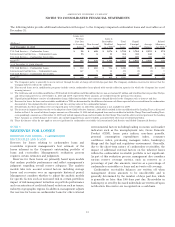American Express 2010 Annual Report Download - page 88
Download and view the complete annual report
Please find page 88 of the 2010 American Express annual report below. You can navigate through the pages in the report by either clicking on the pages listed below, or by using the keyword search tool below to find specific information within the annual report.
LENDING TRUST — IMPACT ON THE CONSOLIDATED BALANCE SHEET
The following table summarizes the major balance sheet impacts, including adjustments associated with the adoption of new GAAP
effective January 1, 2010, for the consolidation of the Lending Trust:
(Billions)
Balance
December 31, 2009 Adjustments
Adjusted Balance
January 1, 2010
Cardmember loans $ 32.8 $ 29.0 $ 61.8
Loss reserves (cardmember loans) (3.3) (2.5) (5.8)
Investment securities 24.3 (3.6) 20.7
Other receivables 5.1 (1.9) 3.2
Other assets 13.2 2.2 15.4
Long-term debt 52.3 25.0 77.3
Shareholders’ equity 14.4 (1.8) 12.6
The primary changes to the Company’s Consolidated Balance Sheets were:
•An increase to cardmember loans (including impaired loans and pledged loans) for the cardmember loans held by the Lending Trust;
•An increase to cardmember loans for the subordinated accrued interest receivable for cardmember loans held by the Lending Trust,
with a corresponding decrease in other assets;
•Establishment of a cardmember reserve for losses for the additional cardmember loans;
•The elimination in consolidation of the Company’s retained subordinated securities against the debt securities issued by the
Lending Trust;
•The elimination of the interest-only strip;
•An increase to long-term debt for the debt securities issued by the Lending Trust;
•A reduction to shareholders’ equity, primarily for the after-tax effect of establishing the additional reserve for losses on cardmember
loans, and for reversing the unrealized gains of the retained subordinated securities.
CHARGE TRUST AND LENDING TRUST
TRIGGERING EVENTS
Under the respective terms of the Charge Trust and the Lending
Trust agreements, the occurrence of certain events could result
in establishment of reserve funds, or in a worst-case scenario,
early amortization of investor certificates. As of December 31,
2010, no triggering events have occurred resulting in funding of
reserve accounts or early amortization.
The Company announced in the second quarter of 2009 that
certain actions affecting outstanding series of securities issued
by the Lending Trust were completed in order to adjust the
credit enhancement structure of substantially all of the
outstanding series of securities previously issued by the
Lending Trust. One of these enhancements was the
designation of a percentage of new principal receivables
arising from accounts in the Lending Trust as “Discount
Option Receivables” (as defined in the Lending Trust
documentation). The designated percentage was reduced to
zero percent in the third quarter of 2010 given that the trust
excess spread had exceeded pre-determined targets.
SECURITIZATION INCOME, NET
As a result of the adoption of new GAAP effective January 1,
2010, the Company no longer recognizes securitization income,
net. The components of securitization income, net for the
cardmember loans and long-term debt, are now recorded in
other commissions and fees, interest income and
interest expense.
The following table summarizes the activity related to
securitized loans reported in securitization income, net, prior
to adoption of the new accounting standards:
(Millions) 2009 2008
Excess spread, net
(a)
$ (155) $ 544
Servicing fees 562 543
Losses on securitizations
(b)
(7) (17)
Securitization income, net $ 400 $ 1,070
(a) Excess spread, net was the net cash flow from interest and fee collections
allocated to the investors’ interests after deducting the interest paid on
investor certificates, credit losses, contractual servicing fees, other expenses,
and the changes in the fair value of the interest-only strip. This amount
excludes issuer rate fees on the securitized accounts, which were recorded in
discount revenue in the Company’s Consolidated Statements of Income.
(b) Excludes $201 million and $(393) million of impact from cardmember loan
sales and maturities for 2009, reflected in the provisions for losses for the
period. Excludes $446 million and $(177) million of impact from
cardmember loan sales and maturities for 2008, reflected in the
provisions for losses for the period.
86
AMERICAN EXPRESS COMPANY
NOTES TO CONSOLIDATED FINANCIAL STATEMENTS
























